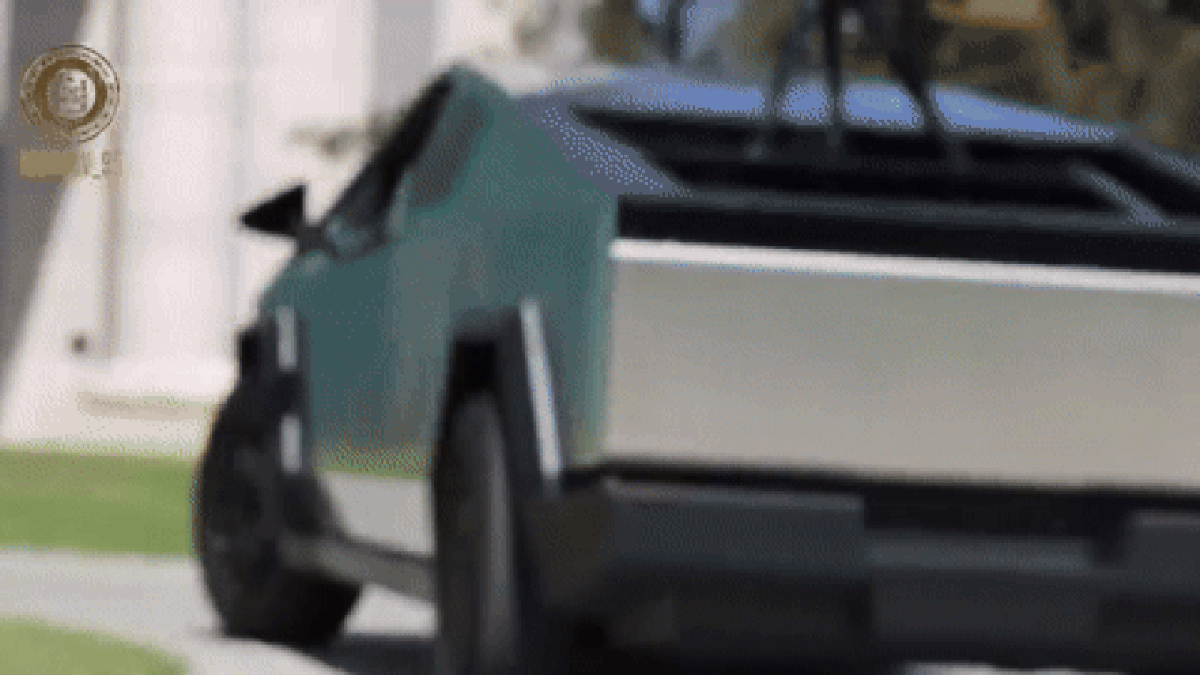Tesla Cybertrucks are headed to war. No, this isn’t a joke. A handful of Chechen soldiers are supposed to ride into battle in Ukraine with Cybertrucks. Ramzan Kadyrov, a Chechen warlord and the leader of the region, posted two green CTs armed with Soviet-era DShK 12.7 x 108 mm heavy machine guns. They’re meant to further Russia’s ongoing invasion of Ukraine as they fight alongside Russian forces.
Footage shows the two Cybertrucks driving down a dirt road as part of a four-vehicle platoon. You could see soldiers standing in the beds of the two trucks, manning those aforementioned machine guns and shooting down airborne targets, according to Wired. Wired says the warlord captioned the Telegram post with a glowing review of the Cybertruck’s benefits on the battlefield, writing “Mobility, convenience, maneuverability: such qualities of an electric vehicle are in great demand here.”
Here’s more, from Wired:
The new footage came just over a month after Kadyrov published an initial video to Telegram showing off a Cybertruck armed with a Russian Kord 12.7 x 108 mm heavy machine gun. That Cybertruck, Kadyrov claimed in a separate Telegram post made the day before unveiling the fresh pair of vehicles, had recently been disabled “remotely” by Tesla chief Elon Musk, who had previously denied gifting the notorious warlord the vehicle in the first place, likely because it’s prohibited under US sanctions on Russia.
Kadyrov responded to the action, saying “This is not manly,” on Telegram, according to Wired.
Putting machine guns on the back of pickup trucks isn’t exactly a new concept.
It was only a matter of time before some enterprising combatant somewhere slapped a machine gun on a Cybertruck. Both regular militaries and irregular forces around the world have been whipping up “technicals”—or “nonstandard tactical vehicles” improvised from civilian rides—for more than a century. While the general concept of armored cars outfitted with firearms presaged the outbreak of World War I by at least a decade, the conflict accelerated their production and fielding—and, in moments of necessity, innovation. In one of the earliest documented manifestations of the technical, French navy lieutenant Maxime François Émile Destremau prepared a defense of the strategically important coaling station in the city of Papeete in Tahiti against a pair of German cruisers in September 1914 by tearing six 37 mm cannons off the warship under his command and mounting them on six Ford trucks to repel potential landing parties, according to the 2004 book On Armor. As long as the automobile has existed, so has the technical.
The technical as most defense observers know it, built on commercial flatbed pickup trucks like the rugged and reliable Toyota Hilux and Land Cruiser, became a fixture of modern irregular warfare during the so-called “Toyota War” of the 1980s that saw militia forces from Chad achieve a decisive victory over the Libyan military thanks to the superior mobility and maneuverability afforded by their lightweight vehicles. (Chadian forces discovered that, at an appropriately high speed, technicals could traverse open areas mined with Soviet-era munitions without risk of setting them off.)
Since then, technicals have become a fixture of conflicts like the US military campaigns in Afghanistan and Iraq, the Syrian and Libyan Civil Wars, and now the Russian invasion of Ukraine. And those conflicts continued to prompt a flurry of novel innovations when it comes to improvised fighting vehicles. Examples include Libyan militants mounting a S-5 rocket pod meant for an aircraft on the back of a truck and a Land Cruiser outfitted with a Russian-made 14.5 mm ZPU-2 antiaircraft gun that American soldiers traded two cans of chewing tobacco for to secure Hamid Karzai International Airport in Kabul during the US withdrawal from Afghanistan in 2021—the latter of which is now in a US military museum. (Does a DShK on a shopping cart count as a technical? That’s up for debate.)
This all begs the question, though: will the Cybertruck actually be a good vehicle on the battlefield? I’m not so sure, and no one else really is either. Here’s what Wired has to say about the situation:
Despite the many issues that have plagued the Cybertruck since its release, the vehicle isn’t necessarily the worst option. While the Cybertruck currently has a maximum range of 340 miles (or 500 miles with an extra battery pack)—well behind the roughly 570- to 700-mile range of the Hilux—the former is actually quicker, capable of accelerating up to 60 mph between 2.6 and 3.9 seconds, depending on the model, a noteworthy achievement given the vehicle’s size and weight.
In terms of safeguarding its occupants from external threats like small arms fire, the Cybertruck’s steel “exoskeleton” offers purportedly superior protection to that of the conventional pickup truck, a feature that Tesla has been quick to flaunt on promotional materials. Finally, the Cybertruck, as an electric vehicle, is freakishly quiet, offering an element of stealth that the US Defense Department in particular has eyed in recent years compared to other fossil-fuel-powered ground vehicles.
Mark Cancian, a retired Marine colonel and a senior advisor at the Center for Strategic and International Studies think tank, isn’t exactly convinced the Cybertruck will work on the battlefield. He said the trucks are “totally cool and totally useless.” So, he’s half right, I guess. Cancian said they were cool because they “look like something out of a video game and portray Kadyrov as a sort of futuristic warlord,” but they are useless because they “don’t provide a new capability, except perhaps a bit of stealth.” He’s not wrong about that. I’d also really like to know how charging will work on the battlefield. Cancian said a fleet of Cybertrucks would “likely be impossible to support.”


